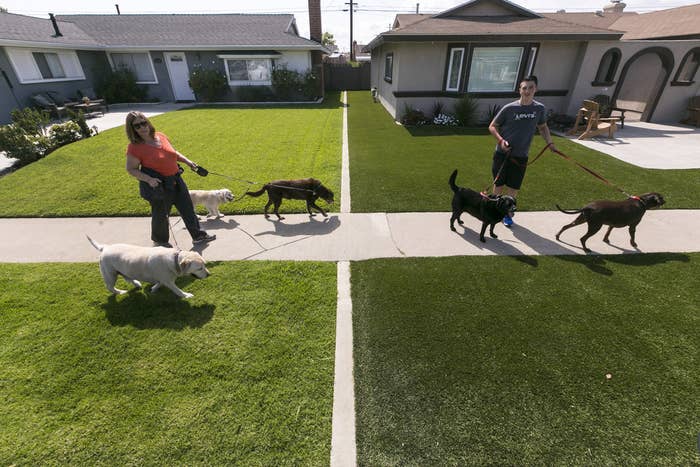
California is bringing down the hammer on one of its most iconic symbols: the lawn.
Under a set of rules adopted Tuesday, new California homes will be allowed to have far less grass than they did in the past. The changes mean only about 25% of a lot can be covered in turf, down from about one-third previously.
The rules were loosened slightly after a public comment period, but still represent a major reduction over what was allowed in the past. Existing homes and yards won't be affected by the rules unless they undergo significant renovations.
The regulations also virtually ban lawns on new commercial and institutional facilities unless grass is part of their design, as in the case of a sports field. Other parts of the regulations encourage water recycling and require more efficient irrigation systems.
The rules go into effect on Dec. 1 and should cut the water use of new homes by 20%, or 12,000 gallons for each house, per year, according to a statement from the California Department of Water Resources.
The proposed lawn rules comes as California's drought forces a cultural paradigm shift in a state known for sprawling neighborhoods and grassy yards.
California has been famous for its sprawling, single-family homes and big yards for generations. But the ongoing drought is proving to be a game changer, at least in the way that officials are responding.
On the one hand, local officials up and down the state have rolled an array of short-term strategies to cut back on the amount of water their communities need. So, many cities restrict the number of days homeowners can water lawns. Others hand out steep fines to people who use too much water.
These measures are actually working, with officials announcing earlier this month that California cities cut down on their water use by 28.9%.
But the new regulations about lawns represent something far more fundamental: Unlike restricted watering days or big fines, they presumably won't disappear when the drought ends. Instead, regulations requiring smaller lawns represent deeper, much longer-term efforts to create an urban environment that uses far less water — whether there is a drought at any particular moment or not.

These changes are all part of a cultural shift that ultimately may dislodge a sprawling lawn from Californians' idea of the American dream, according to Tracy Quinn, a water policy analyst at the Natural Resources Defense Council.
"I think we’re all going to regret taking drinking water and throwing it outdoors," Quinn told BuzzFeed News.
Quinn called the new regulations "definitely an important step forward." And while they don't impact existing homes, Quinn was hopeful that new developments would offer a example that might gradually set a precedent for established communities.
"What this could do is demonstrate that water efficient landscapes can be really beautiful," she added.
In a conversation with BuzzFeed News, Peter Gleick — a climate scientist and president of the Pacific Institute — called outdoor landscaping one of California's "biggest untapped uses of water" and said efforts to rein in that use are a step in the right direction.
"We waste a lot of water on landscapes that are not appropriate for our environment," he added.
Gleick explained that California's lawns are a holdover from development on the East Coast, where the suburbs were first conceived, and from Europe. In the early days of the suburbs, "the lawn was considered the fundamental beautiful landscape."
"When we moved out west we brought that conception of a beautiful suburban landscape even though the climate was different," Gleick added.
Now, the drought is forcing California to fundamentally re-evaluate its idea of beauty, which Gleick said is a good thing.
"Even when the drought ends, there’s not enough water do to everything we want and there have to be some longer-term changes," he said. "We have to fundamentally change the way we think about lawns."
